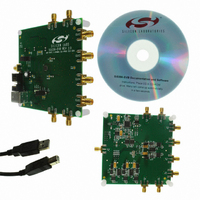SI5356-EVB Silicon Laboratories Inc, SI5356-EVB Datasheet - Page 11

SI5356-EVB
Manufacturer Part Number
SI5356-EVB
Description
EVALUATION BOARD FOR SI5356
Manufacturer
Silicon Laboratories Inc
Specifications of SI5356-EVB
Main Purpose
Timing, Clock Generator
Utilized Ic / Part
SI5356
Technology Type
Evaluation Board
For Use With/related Products
Si5356
Lead Free Status / RoHS Status
Lead free / RoHS Compliant
Secondary Attributes
-
Embedded
-
Primary Attributes
-
Lead Free Status / Rohs Status
Lead free / RoHS Compliant
Other names
336-1750
3.4. Frequency Configuration
The Si5356 utilizes a single PLL-based architecture,
four independent MultiSynth fractional output dividers,
and a MultiSynth fractional feedback divider such that a
single device provides the clock generation capability of
four independent PLLs. Unlike competitive multi-PLL
solutions, the Si5356 can generate four unique non-
integer related output frequencies with 0 ppm frequency
error, with respect to the reference, for any combination
of output frequencies. In addition, any combination of
output frequencies can be generated from a single
reference frequency without having to change the
crystal
configurations.
Frequency configurations are fully programmable by
writing to device registers using the I
combination of output frequencies ranging from 1 to
200 MHz can be configured on each of the device
outputs.
The following equation governs how the output
frequency is calculated.
where f
feedback divider value, P is the reference divider value,
M
resulting output frequency. The MultiSynth output and
feedback dividers are fractional dividers expressed in
terms of an integer and a fraction. The integer portion
has 10-bit resolution and the fractional portion has 30-
bit resolution in both the numerator and denominator,
meaning that any output frequency can be defined
exactly from the input frequency with exact (0 ppm)
frequency synthesis error.
3.5. Configuring the Si5356
The Si5356 is a highly-flexible clock generator that is
entirely configurable through its I
device’s default configuration is stored in non-volatile
memory (NVM) as shown in Figure 4. The NVM is a
one-time programmable memory (OTP), which can
store a custom user configuration at power-up. This is a
useful feature for applications that need a clock present
at power-up (e.g., for providing a clock to a processor).
i
is the MultiSynth output divider value and f
Figure 4. Si5356 Memory Configuration
IN
or
is the reference frequency, N is the MultiSynth
reference
f
OUT
Default
Config
(OTP)
Power-Up/POR
NVM
=
clock
f
---------------- -
P M
IN
RAM
I
2
C
N
i
frequency
2
C interface. The
2
C interface. Any
OUT
between
Preliminary Rev. 0.3
is the
During a power cycle or a power-on reset (POR), the
contents of the NVM are copied into random access
memory (RAM), which sets the device configuration that
will be used during operation. Any changes to the
device configuration after power-up are made by
reading and writing to registers in the RAM space
through the I
"3.1.1. ClockBuilder™ Desktop Software" on page 9)
can be used to easily configure register map files that
can be written into RAM (see “3.5.2. Creating a New
Configuration for RAM” for details). Alternatively, the
register map file can be created manually with the help
of the equations in AN565.
Two versions of the Si5356 are available. First, non-
customized Si5356 devices are available in which the
RAM can be configured in-circuit via I
Si5356 devices can also be field programmed using the
Si5338/56-PROG-EVB (see “3.5.5. Writing a Custom
Configuration to NVM”). Second, custom factory-
programmed Si5356 devices are available that include
a
(example part number Si5356A-Axxxxx-GM).
3.5.1. Ordering a Custom NVM Configuration
The Si5356 is orderable with a factory-programmed
custom NVM configuration. This is the simplest way of
using the Si5356 since it generates the desired output
frequencies at power-up or after a power-on reset
(POR). This default configuration can be reconfigured in
RAM through the I
“3.5.2. Creating a New Configuration for RAM”).
The first step in ordering a custom device is generating
an NVM file which defines the input and output clock
frequencies and signal formats. This is easily done
using the NVMSave for Factory Programming... menu
option
ClockBuilder™ Desktop Software" on page 9.) This
Windows based software allows the user to generate an
NVM file, which is used by the factory to manufacture
custom parts. Each custom part is marked with a unique
part number identifying the specific configuration (e.g.,
Si5356A-A00100-GM).
Consult your local sales representative for more details
on ordering a custom Si5356.
3.5.2. Creating a New Configuration for RAM
Any Si5356 device can be configured by writing to
registers in RAM through the I
factory programmed device must be configured in this
manner.
user-specified
in
2
ClockBuilder
C interface. ClockBuilder Desktop (see
2
startup
C interface after power-up (see
Desktop.
frequency
2
C interface. A non-
2
C. These blank
Si5356
(See
configuration
"3.1.1.
11










